Side Menu: The Mystery
Alternative Accounts:
Charles Herbert Lightoller
Second Officer

“[I] refute the reports that were spread in the newspapers. I was practically the last man, and certainly the last officer, to see Mr. Murdoch. He was then endeavouring to launch the starboard forward collapsible boat …Other reports as to the ending are absolutely false. Mr. Murdoch died like a man, doing his duty.”
“Before joining White Star, Lightoller had led an adventurous life. He had been shipwrecked on a deserted island, prospected for gold in Yukon and worked as a cowboy in the Canadian West. Now he was a career man who expected to command his own ship one day. He could be intolerant of those who did not follow orders to the letter or whom he considered to use poor judgment.” (Illustrated History, p.76 (2.))
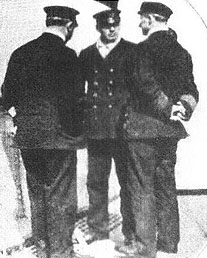
Lightoller (centre) on the Carpathia
with Captain Rostron (right)
and another Carpathia officer
As has already been discussed, Edkins suggests that there was a certain degree of friction between Lightoller and Chief Officer Wilde (though George Behe disputes it (11.)), while Lightoller was on good terms with Murdoch, having also served aboard the liner Arabic on the occasion when Murdoch averted a collision. Lightoller was put in charge of the port side evacuation and found refuge on upturned collapsible B when it was washed off the deck.
His testimony regarding Murdoch is in two parts: evidence he supplied in the inquiries and in a personal letter he wrote to Murdoch’s wife, Ada.
On Day One of the United States Inquiry, Second Officer Charles Herbert Lightoller gave the following testimony when interviewed by Senator Smith:
Smith: Did you see Mr. Murdoch after that? [the change in watch]
Lightoller: Yes sir; I saw him when I came out of the quarters after the impact.
Smith: Where was he?
Lightoller: On the bridge.
Smith: With the captain?
Lightoller: One on one side, and the one on the other side of the bridge; one on each side.
Smith: Did you speak to him after that?
Lightoller: No, sir.
Smith: I mean after he took the watch?
Lightoller: No, sir.
Smith: You never spoke to him again?
Lightoller: No, sir.
Smith: You were not together when you finally parted from the ship?
Lightoller: No, sir.
Smith: You saw him on the bridge at that time?
Lightoller: Immediately after the impact, yes sir.
Smith: Did he remain there until the end?
Lightoller: He was getting the boats out on the starboard side later on.
Smith: Later?
Lightoller: Yes, sir.
Smith: Did you see him at that work?
Lightoller: No, sir; I was on the port side.
Smith: How do you know that he did it?
Lightoller: I saw him at the last boat.
Smith: Just what time he left the bridge, I don’t suppose you know.
Lightoller: No, sir….
Smith: Do you know who had charge on the starboard side of the lowering and filling of the boats?
Lightoller: No, sir. Merely what I am told.
Smith: What have you been told about it? Maybe we can get something from that.
Lightoller: As far as I know, and I think it is correct, Mr. Murdoch. Mr. Murdoch was on the starboard side. I was on the port side, and Mr. Murdoch
was on the starboard side, and the chief officer was superintending generally, and lowered one or two boats himself.
Smith: From whom did you get that information?
Lightoller: Of course, I saw Mr. Murdoch there when finally I had finished the port side.
Smith: You went to the starboard side?
Lightoller: On top; yes, sir.
Smith: For the purpose of lowering…
Lightoller: I went over to see if I could assist.
Smith: And you saw him there. From anything you have been told, did he pursue the same course on the starboard side in reference to the filling of the
lifeboats, and the complement of seamen as you did?
Lightoller: That I could not say.(25.)
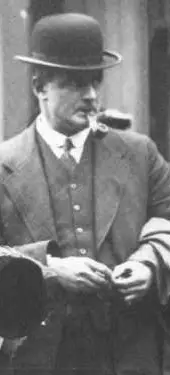
Lightoller appearing at the
inquiry after the disaster
On the 21 May, 1912, at the British Inquiry, Lightoller also said: “I saw the First Officer working at the falls of the starboard emergency boat, obviously with the intention of overhauling them and hooking on to the collapsible boat on their side...There were a number round there helping... she seemed to take a bit of a dive, and I just walked into the water." And later "Mr. Murdoch I saw practically at the actual moment that I went under water.. He was then working at the forward fall, on the starboard side forward; that is the fall to connect to the collapsible boat." (24.)
The letter written to Murdoch's wife, Ada, has been reprinted in full and included in this document, but the most salient points from it are:
“[I] refute the reports that were spread in the newspapers. I was practically the last man, and certainly the last officer, to see Mr. Murdoch. He was then endeavouring to launch the starboard forward collapsible boat.”
He also states that “having got my boat down off the top of the house, and there being no time to open it, I left it and ran across to the starboard side, still on top of the quarters. I was then practically looking down on your husband and his men. He was working hard, personally assisting, overhauling the forward boat’s fall. At this moment the ship dived, and we were all in the water. Other reports as to the ending are absolutely false. Mr. Murdoch died like a man, doing his duty.”
The letter, dated April 24th, 1912 and written in the Hotel Continental, Washington, was signed by Officers Lightoller, Boxhall, Pitman and Lowe and later published in the Dumfries & Galloway Standard & Advertiser on May 11th, 1912.
The letter in full is as follows, courtesy of Richard Edkins, Murdoch of the Titanic.
Hotel Continental,
Washington.
April 24th, 1912.
Dear Mrs. Murdoch,
I am writing on behalf of the surviving officers to express our deep sympathy in this, your awful loss. Words cannot convey our feelings, - much
less a letter.
I deeply regret that I missed communicating with you by last mail to refute the reports that were spread in the newspapers. I was practically the
last man, and certainly the last officer, to see Mr. Murdoch. He was then endeavouring to launch the starboard forward collapsible boat. I had already got
mine from off the top of our quarters. You will understand when I say that I was working the the port side of the ship, and Mr. Murdoch was principally
engaged on the starboard side of the ship, filling and launching the boats. Having got my boat down off the top of the house, and there being no time to
open it, I left it and ran across to the starboard side, still on top of the quarters. I was then practically looking down on your husband and his men. He
was working hard, personally assisting, overhauling the forward boat's fall. At this moment the ship dived, and we were all in the water. Other reports as
to the ending are absolutely false. Mr. Murdoch died like a man, doing his duty. Call on us without hesitation for anything we can do for you.
Yours very sincerely,
C.H.Lightoller, 2d Officer;
J. Grove Boxhall, 4th Officer;
H.J. Pitman, 3d Officer;
H.G. Lowe, 5th Officer.
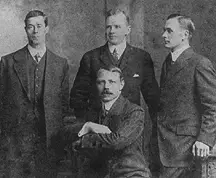
Surviving officers Lowe, Pitman,
Lightoller and Boxhall after the disaster.
(Click image to enlarge)
There is no question over Lightoller’s location and time-frame being in line with the location and time-frame of the alleged suicide. And as the most senior surviving officer and friend of Murdoch, his evidence is compelling. However, there are two key areas of uncertainty in his accounts.
Also Colonel Archibal Gracie in his book The Truth About Titanic mentions that Lightoller did identify Murdoch at collapsible A: "Lightoller also told me on board the Carpathia that he saw Murdoch when he was engulfed by the water and that if before this a pistol had been fired within the short distance that separated them, he also is confident he would have heard it." (Colonel Archibald Gracie, The Truth About Titanic (43.))
Location
Lightoller states that he was positioned on the officer’s quarter’s roof when he last saw Murdoch. Under questioning from Senator Smith, he attempted to pinpoint his position:
Lightoller: …As I say, I was on top of the officers’ quarters, and there was nothing more to be done. The ship then took a dive, and I
turned face forward and also took a dive.
Smith: From which side?
Lightoller: From on top, practically amidships; a little to the starboard side, where I had got to. (25.)
According to George Behe, the above testimony and that of another survivor confirms that Lightoller did not actually “see” Murdoch in the true sense of the word:
“Lightoller makes it clear here that he was practically amidships on the roof of the officers’ quarters when the ship made a sudden dip downward (at which time the wave swept over the boat deck.) This of course suggests that Lightoller was in no position to see Murdoch down on the starboard boat deck when the water rose to where Murdoch had been working beside Collapsible A. It therefore follows that Lightoller did not really *know* what happened to Murdoch after leaving the starboard roof of the officers’ quarters and moving amidships to where he eventually dove overboard.
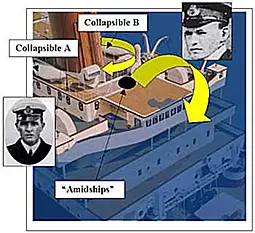
According to Lightoller’s (above right)
testimony, he jumped into the ocean
from
off the officers’ quarters roof “amidships”.
“Corroboration of this suggestion comes in the form of an interview given by survivor Victor Sunderland. According to Sunderland, the ship trembled and dropped suddenly, at which point Second Officer Lightoller shouted, ‘Here she goes!’ and jumped over the port side. Sunderland said he followed Lightoller over the port side and later found refuge on the same overturned lifeboat (Collapsible B on the port side) that saved the Second Officer. If this interview is reliable, it shows that the Titanic's Second Officer was definitely in no position to know what fate had befallen First Officer Murdoch on the starboard side. ” (George Behe, First Officer Murdoch and the ‘Dalbeattie Defense’ (11.) ).
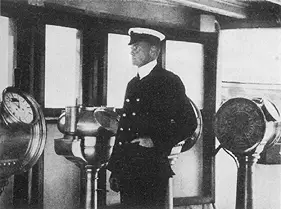
Lightoller was First Officer on the Oceanic prior to
his transfer to Titanic.(Click image to enlarge)
Paul Quinn, in Titanic at 2A.M., takes this a step further and asks: “Why was he standing over there when there was critical work to be done in getting collapsible B off?… What would have caused Lightoller to stop assisting with the port side collapsible on the roof, with so little time left, and instead walk around the funnel to the starboard side where there was no work to be done? Something drew Lightoller over to the starboard side…” (Paul Quinn, Titanic at 2 A.M., p.77 (34.) )
As to what drew Lightoller’s attention, Quinn suggests that it possibly may have something to do with Murdoch’s alleged suicide and he then asks: “In the midst of the crowd, did Murdoch lift the gun to his head and fire?”
In summary, it seems logical that Lightoller may have seen or been aware of Murdoch working on collapsible A, but it would be impossible for him to have known everything that occurred on the starboard side. And notably, he did not apparantly see what caused Murdoch's death.
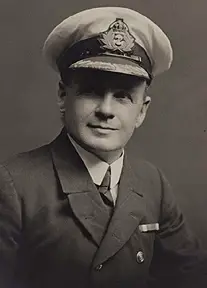
Lightoller in later years.
(Click image to enlarge)
Reliability
Lightoller’s reliability has been questioned. In regard to using his revolver during the evacuation, Lightoller gave several differing versions depending on who he was talking to (Illustrated History, p.132 (2.)). And notably, under oath he said “no, sir” to the suggestion that he talked to Murdoch about the iceberg situation at the 10pm change-over. He later recanted this testimony, saying that he did in fact mention that they “might be up around the ice any time now” (refer to the section Hard-A-Starboard). Was he trying to protect Murdoch from being implicated in any negligence concerning the proximity of ice? Other parts of his testimony are also a little dubious, (with ambiguous “sources” that he had conveniently forgotten) quite obviously tainted by a subtle appeasement of his employers, while still maintaining the dictates demanded by a witness under oath.
Hence Bill Wormstedt asks: “Did Lightoller tell the truth about William Murdoch’s death...? That is unknown, but Lightoller was known to have protected his job, and his fellow officer’s and employer’s reputations by ‘whitewashing’ his testimony in the disaster inquiries.” Wormstedt also raises an interesting point:
“William Murdoch biographer Susanne Stormer discovered that later in life when he was living in Hertfordshire, Lightoller is said to have admitted that he ‘knew someone who committed suicide that night,’ but as far as she knows, he never said who. Lightoller’s private admission was a widely discussed subject during the 1997 Irish Titanic Historical Society convention.” (Bill Wormstedt, Shots in the Dark (12.))
George Behe also mentions this:
“Interestingly, researcher Susanne Stormer has spoken with a friend of the Lightoller family, and Lightoller -- in later years -- is said to have admitted that he knew someone on the Titanic who had taken his own life. This does not prove that Lightoller was talking about Murdoch, of course, but it does demonstrate that Lightoller did not tell everything he knew about the Titanic disaster when the inquiries were taking place in 1912.” (George Behe, First Officer Murdoch and the ‘Dalbeattie Defense’ (11.))
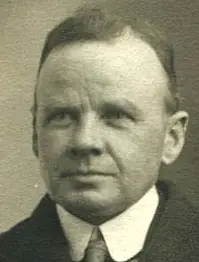
Lightoller in his later years.
Additionally, according to Earl J Chapman's article Gunshots on the Titanic there is an account related by Titanic author Diana Bristow in two of her books (Titanic: R.I.P., and Titanic: Sinking the Myths (35.)) that "mentions a gunshot wound to the jaw" being reported by Lightoller- but goes even further and names Murdoch as the officer who did it. He explains:
"During her research into the disaster, Bristow received a letter from James O. McGiffin in which he related details of a shooting incident involving First Officer William Murdoch which was told to him by his father, Captain James McGiffin. Captain McGiffin was a close personal friend to Murdoch, and served with both Murdoch and Charles Lightoller (Second Officer on the Titanic) on White Star's Medic around 1900. Captain McGiffin ended up as White Star's Marine Superintendent in Queenstown during the period 1903-1912. After Titanic sank, Lightoller saw Captain McGiffin and naturally told him all about the disaster, including the Murdoch shooting incident." (27.)
The references by Diana Bristow are as follows:
"Lightoller told my father in Queenstown that Mr. Bruce Ismay kept pressure on Captain Smith to keep the Titanic to her maximum speed of 22-23 knots in order to create a new record time for the souther track crossing of the Atlantic. This Captain Smith did in spite of ice warnings from other ships in the area... Murdoch shot one crewman in the jaw as he tried to rush the lifeboats... (Titanic: R.I.P. Diana Bristow, p.172 (35.)):
"After Titanic sank, Lightoller saw McGiffin and naturally told him all about the disaster, including the fact that Murdoch had been forced to shoot a crewman who led a rush on one of the lifeboats, pushing aside women and children. The bullet struck the man's jaw." (Titanic: Sinking the Myths, Diana Bristow p.49 (36.))
Richard Edkin’s website uses Lightoller’s letter as evidence that Murdoch did not commit suicide, but even Edkins himself doubts the Second Officer’s reliability: “Lightoller's later evidence in the Board of Trade enquiry has lead to accusations that he was concealing facts to help the White Star Line… As a personality, Lightoller was rather flamboyant and prone to advertise his own importance, and his prejudices to others coloured his evi-dence. As an example, he disliked both Smith and Wilde, whose arrival on Titanic had reduced Lightoller from First to Second Officer.” (Richard Edkins, Murdoch of the Titanic (1.))
In addition, Don Lynch writes: “Certainly Lightoller’s testimony [regarding Murdoch] can be discounted –he may well have been attempting to protect the reputation of a fellow White Star officer, as well as that of his employers.” (Illustrated History, p.195 (2.) )
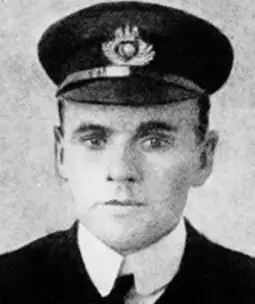
Second Officer Lightoller's reliability
has been questioned, not to mention
that it seems he did not see
what actually caused Murdoch's
death to be in a position
to rule out suicide.
It should also be remembered that Lightoller was writing a personal letter to his friend’s widow and one would not expect anything other than words of comfort in a time of distress. “Lightoller’s motives may have been humanitarian in nature,” George Behe writes. “His purpose in writing to Murdoch's widow was to soften the blow of her husband’s death.” (George Behe, First Officer Murdoch and the ‘Dalbeattie Defense’ (11.)) Or as Wormstedt puts it, “just trying to console a grieving widow” (Bill Wormstedt, Shots in the Dark (12.)). Since Lightoller did not see any evidence himself of a suicide, it would be a natural response to vigourously refute it. Third Officer Pitman, Fourth Officer Boxhall and Fifth Officer Lowe, although they co-signed the letter, were not within the location or time-frame to personally validify Lightoller’s assumption (Pitman sent off in No.5 at 12:55am, Boxhall in No.2 at 1:45am and Lowe in No.14 at 1:30am).
Additionally, this was not the first time for Lightoller to write such a letter. In March 2012 it was reported that Lightoller also wrote a letter regarding assistant surgeon Dr Simpson's death with very similar wording as the one to Ada Murdoch, and was sold at an auction for $14,000. A typewritten letter, on Titanic letterhead and dated May 1, 1912, Lightoller's letter also gives details regarding Simpson's death, to validify a report that "Simpson stood with fellow officers on the deck of the stricken vessel as it went down, resigning themselves to their fate, making no attempt to board the lifeboats and instead calmly helped others to safety." In his letter Lightoller writes: "I may say I was practically the last man to speak to Dr. Simpson. They were all perfectly calm in the knowledge that they had done their duty and were still assisting by showing a calm and cool exterior to the passengers" (source). This of course raises the simple question of how many crew families Lightoller wrote to personally vouching for such herioc deaths of their loved ones. Was it possible in those final moments before the ship sank beneath his feet that he could spend time observing their precise manner of death? Or, as the senior surviving officer did he feel it was his duty (or perhaps asked by the White Star Line) to write to families to try to allay their grief?
However Edkins states that Lightoller's letter to Ada “shows impulsive outrage rather than an attempt to conceal the truth” and that “his evidence can be relied upon where others’ evidence corroborates it… The evidence of the painfully honest Harold Bride, the Second Wireless Operator, corroborates that of Lightoller in regard to Murdoch's final moments.” (1.)